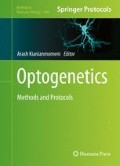Abstract
The control of spatiotemporal dynamics in biological systems is a fundamental problem in nonlinear sciences and has important applications in engineering and medicine. Optogenetic tools combined with advanced optical technologies provide unique opportunities to develop and validate novel approaches to control spatiotemporal complexity in neuronal and cardiac systems. Understanding of the mechanisms and instabilities underlying the onset, perpetuation, and control of cardiac arrhythmias will enable the development and translation of novel therapeutic approaches. Here we describe in detail the preparation and optical mapping of transgenic channelrhodopsin-2 (ChR2) mouse hearts, cardiac cell cultures, and the optical setup for photostimulation using digital light processing.
Access this chapter
Tax calculation will be finalised at checkout
Purchases are for personal use only
References
Knollmann BC (2010) Pacing lightly: optogenetics gets to the heart. Nat Methods 7:889–891
Deisseroth K (2011) Optogenetics. Nat Methods 8:26–29
Rein ML, Deussing JM (2012) The optogenetic (r)evolution. Mol Genet Genomics 287:95–109
Bruegmann T, Malan D, Hesse M, Beiert T, Fuegemann CJ, Fleischmann BK, Sasse P (2010) Optogenetic control of heart muscle in vitro and in vivo. Nat Methods 7:897–900
Davidenko JM, Pertsov AV, Salamonsz R, Baxter W, Jalife J (1992) Stationary and drifting spiral waves of excitation in isolated cardiac muscle. Nature 355:349–351
Panfilov AV, Holden AV (1990) Self-generation of turbulent vortices in a two dimensional model of cardiac tissue. Phys Lett A 151:23–26
Jalife J, Gray RA, Morley GE, Davidenko JM (1998) Self-organization and the dynamical nature of ventricular fibrillation. Chaos 8:79–93
Walcott GP, Killingsworth CR, Ideker RE (2003) Do clinically relevant transthoracic defibrillation energies cause myocardial damage and dysfunction? Resuscitation 59:59–70
Zipes DP, Jalife J (eds) (2009) Cardiac electrophysiology: from cell to bedside. Saunders/Elsevier, Philadelphia. ISBN 9781416059738
Fenton FH, Luther S, Cherry EM, Otani NF, Krinsky VI, Pumir A, Bodenschatz E, Gilmour RF (2009) Termination of atrial fibrillation using pulsed low-energy far-field stimulation. Circulation 120:467–476
Luther S, Fenton FH, Kornreich BG, Squires A, Bittihn P, Hornung D, Zabel M, Flanders J, Gladuli A, Campoy L, Cherry EM, Luther G, Hasenfuss G, Krinsky VI, Pumir A, Gilmour RF Jr, Bodenschatz E (2011) Low-energy control of electrical turbulence in the heart. Nature 475:235–239
Bruegmann T, Malan D, Hesse M, Beiert T, Fuegemann CJ, Fleischmann BK, Sasse P (2011) Channelrhodopsin2 expression in cardiomyocytes: a new tool for light-induced depolarization with high spatiotemporal resolution in vitro and in vivo. Thorac cardiovasc Surg 59-S01:MO19. doi:10.1055/s-0030-1269109
Sasse P (2011) Optical pacing of the heart: the long way to enlightenment. Circ Arrhythm Electrophysiol 4:598–600
Stirman JN, Crane MM, Husson SJ, Gottschalk A, Lu H (2012) A multispectral optical illumination system with precise spatiotemporal control for the manipulation of optogenetic reagents. Nat Protoc 7:207–220
Herron TJ, Lee P, Jalife J (2012) Optical imaging of voltage and calcium in cardiac cells & tissues. Circ Res 110:609–623
Ambrosi CM, Entcheva E (2014) Chapter 19—Optogenetic control of cardiomyocytes via viral delivery. In: Milica Radisic, Lauren D. Black III (eds) Methods in molecular biology, vol 1181, chapter 19. Springer Science+Business Media. pp 215–228
Loew LM (2010) Design and use of organic voltage sensitive dyes. In: Canepari M, Zecevic D (eds) Membrane potential imaging in the nervous system: methods and applications, chapter 2. Springer Science+Business Media pp 13–23
Josephson ME (2008) Clinical cardiac electrophysiology: techniques and interpretations. Solution (Lippincott Williams & Wilkins). Wolters Kluwer Health/Lippincott Williams & Wilkins. ISBN 9780781777391
Zhang F, Wang LP, Brauner M, Liewald JF, Kay K, Watzke N, Wood PG, Bamberg E, Nagel G, Gottschalk A, Deisseroth K (2007) Multimodal fast optical interrogation of neural circuitry. Nature 446:633–639
Jia Z, Valiunas V, Lu Z, Bien H, Liu H, Wang H-Z, Rosati B, Brink PR, Cohen IS, Entcheva E (2011) Stimulating cardiac muscle by light: cardiac optogenetics by cell delivery. Circ Arrhythm Electrophysiol 4:753–760
Acknowledgements
The pcDNA3.1/hChR2(H134R)-mCherry was provided by Karl Deisseroth (Addgene plasmid # 20938). We also want to thank M. Kunze and T. Althaus for their technical assistance. The research leading to the results has received funding from the European Community’s Seventh Framework Programme FP7/2007-2013 under Grant Agreement No. HEALTH-F2-2009-241526, EUTrigTreat. The authors acknowledge support from the German Federal Ministry of Education and Research (BMBF) (project FKZ 031A147, GO-Bio), the German Research Foundation (DFG) (Collaborative Research Centers SFB 1002, Projects B05 and C03 and SFB 937 Project A18), and the German Center for Cardiovascular Research (DZHK e.V.).
Author information
Authors and Affiliations
Corresponding author
Editor information
Editors and Affiliations
Rights and permissions
Copyright information
© 2016 Springer Science+Business Media New York
About this protocol
Cite this protocol
Richter, C., Christoph, J., Lehnart, S.E., Luther, S. (2016). Optogenetic Light Crafting Tools for the Control of Cardiac Arrhythmias. In: Kianianmomeni, A. (eds) Optogenetics. Methods in Molecular Biology, vol 1408. Humana Press, New York, NY. https://doi.org/10.1007/978-1-4939-3512-3_20
Download citation
DOI: https://doi.org/10.1007/978-1-4939-3512-3_20
Published:
Publisher Name: Humana Press, New York, NY
Print ISBN: 978-1-4939-3510-9
Online ISBN: 978-1-4939-3512-3
eBook Packages: Springer Protocols

